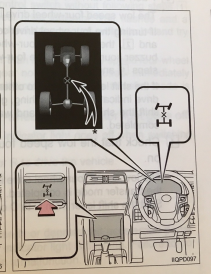
What is diff lock on 4X4 vehicles?
Have you seen these on Toyota or 4X4 vehicles?



A locking differential (or diff locker) can make a significant difference in the performance of your 4wd in certain situations. Known also as diff-lock or locker, it is a modification to the standard differential. Its purpose is to restrict each of the two wheels on an axle to the same rotational speed regardless of the traction available to each wheel. Although an unlocked differential is a fantastic feature in a vehicle traveling on hard surfaces such as sealed roads, it can cause significant problems in some situations that four-wheel drivers may find themselves in.
How a Diff Locker works
So to understand how they work, it is firstly important to understand how a differential works and what it’s purpose is.
The differential has three jobs:
- To aim the engine power at the wheels
- To act as the final gear reduction in the vehicle, slowing the rotational speed of the transmission one final time before it hits the wheels
- To transmit the power to the wheels while allowing them to rotate at different speeds (This is the one that earned the differential its name.)
The key point that is relevant in 4wd terms is the last point. That the differential allows the wheels to spin at different speeds. Further to this, the differential will direct power to the wheel that is easiest to rotate. Such is the nature of the differential. Learn more about 4X4 recovery course
Implications when off road
A four-wheel drive operator will find that there are a number of situations where having a standard differential will be problematic.
Heavy articulation – This is probably the most common situation that a 4wd will find itself in where a diff locker will come in handy. In this situation, the suspension of the car is extended to it’s extreme. For example, when the left front wheel rides up a ridge while the right back wheel is running over a large rock. As you can imagine, this will result in the right front wheel and the left back wheel trying to lift off the ground. So, as they lift, they lose traction. The wheels on the ground will have more resistance, and therefore power will be directed towards the wheels that are lifting up. Resulting in wheel spin and loss of forward momentum, 4×4 stuck. To get past the obstacle, most 4×4 owners will take a run-up, this may results in damage to the vehicle. Learn more about 4WD training
Another common situation where a 4×4 may find a diff locker handy is in a situation where one side of the vehicle has solid traction and the other does not. For example, if the vehicle is driving along a track where one of the wheel ruts is dry and the other is under water. The dry side will have greater traction than the wet muddy side. The wheels with greater traction will resist and power will be directed to the wheels on the muddy side and the result is wheel spin and a bogged 4×4.
Locking the differentials
A diff locker will force the wheels to spin at the same speed regardless of traction. In situations such as when the wheels try to lift off the ground, the locked differential forces the wheels to spin at the same speed. The wheels on the ground continue to drive the vehicle forward and over the rock/ridge. The vehicle is able to navigate the obstacle easily and smoothly. Similarly, in situations such as the vehicle becoming bogged with two wheels spinning, the wheels with traction continue to spin and drive the vehicle forward.
Important or you can break your beautiful 4WD
With the differential locked, it’s important not to drive on surfaces that don’t allow the wheels to slip a little. Surfaces such as solid rock or paved roads or sealed roads will grip the tyres. When you turn, the wheels will all want to spin at different speeds, with differential locked however, this won’t be possible. As you continue to corner incredible strain will be placed on the drive line of your vehicle and will eventually cause things to break. This is called "wind up". So make sure you unlock your diffs before you hit the black top. If you vehicle will not change back into 2 wheel drive try reversing the car 20m, this can help to remove "wind up".
If you drive a Toyota you may have a centre diff lock
